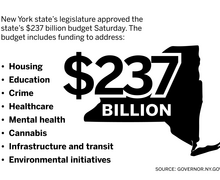New York counties prepare for mail-in voting in November election
Corey Henry | Senior Staff Photographer
Gov. Cuomo said he hopes the legislation will make it easier for New Yorkers to vote in November.
The Daily Orange is a nonprofit newsroom that receives no funding from Syracuse University. Consider donating today to support our mission.
Counties in New York state are taking steps to prepare for a surge in absentee ballots during the upcoming 2020 presidential election.
In the past, absentee ballots were an excuse-based system for voters who were sick or unable to be in Onondaga County on Election Day, said Dustin Czarny, an Onondaga County elections commissioner. New legislation Gov. Andrew Cuomo signed in August extends the illness excuse to include the risk of contracting or spreading the coronavirus.
The county anticipates a substantial increase in mail-in voting this year, Czarny said.
“In the primary, we saw 60% of our voting calculation voted by mail,” he said. “So that will mean instead of giving 10 to 15,000 absentees, we are giving 125,000 absentees.”
Cuomo issued another executive order on Aug. 24, requiring all counties’ boards of elections to prepare for the mail-in voting process. In a press release, Cuomo said he hopes the order will “make it easier for New Yorkers to vote and be counted in November.”
The executive order directs each county’s board of elections to send mail-in vote deadlines to all voters by Tuesday. The order also requires all counties to use the same envelope for absentee ballots to ensure all votes are counted.
Shana Gadarian, chair of Syracuse University’s political science department, said the legislation will make it easier for more people to vote, especially for groups vulnerable to COVID-19.
“Full participation of democracy requires full participation of the voting power,” Gadarian said. “These kinds of things that make it easier also make democracy stronger.”
Expanded mail-in voting has become controversial in recent months, especially after President Donald Trump wrongly claimed that it could lead to voter fraud and foreign interference in the election. Czarny said there is “no evidence or intelligence” to support the president’s claim of foreign interference in mail-in voting.
“When you move to the vote-by-mail process, it does take longer,” Czarny said. “But there’s no evidence, absolutely no evidence, of any voter fraud.”
Trump further opposed giving additional funding to the U.S. Postal Service to account for a swell in mail-in votes. Louis DeJoy, postmaster general, has also come under scrutiny for his role in administering budget cuts to the service.
Four out of 15 sorting machines were removed from the Postal Service center in North Syracuse last month as part of the agency’s cost-cutting measures, Syracuse.com reported.
“The president has already seen that making it easier to vote may benefit Democratic voters who are more concerned about the pandemic than the Republican voters,” Gadarian said. “If he does lose, he can say the system wasn’t fair, rather than people just don’t vote for him.”
Christopher Faricy, a professor of political science at SU, said Trump’s opposition to mail-in voting is likely an effort to call into question the election’s legitimacy.
“The research on mail-in ballots shows that it has historically not advantaged one party’s candidates over another,” Faricy said.
Czarny said 20 board of elections commissioners and representatives from counties in central New York held a meeting with the North Syracuse post office on Friday. The post office confirmed that it will not remove additional sorting machines and that it will be able to process all absentee ballots cast in the area, he said.
The post office suggests that voters send absentee ballot applications no later than Oct. 19. Absentee voters should mail their ballot no later than Oct. 27 to assure it is counted, Czarny said.
“My advice to the voters is to act early,” Czarny said. “If you have a ballot, mail it early.”
Published on September 1, 2020 at 11:53 pm
Contact Francis: btang05@syr.edu | @francis_towne





